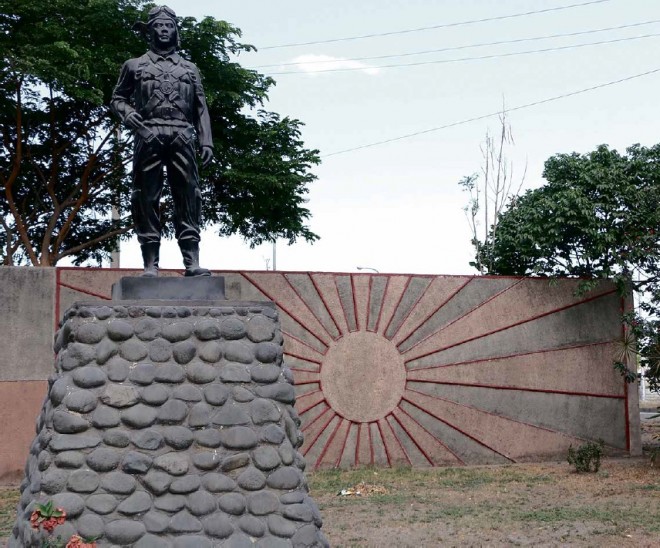
ON A PEDESTAL A statue honoring a kamikaze pilot stands at the Kamikaze East Airfield Peace Memorial in Cacutud village,Mabalacat
City, Pampanga province. The Airfield was built by the local government in 1998. E.I. REYMOND T. OREJAS/CONTRIBUTOR
MABALACAT CITY, Philippines—However they are regarded—as suicide bombers or brave young pilots—the kamikaze pilots of 70 years ago are now the link of this northern Pampanga city to present-day Japanese and to peace advocates.
Memorials for the World War II fighter pilots, collectively called kamikaze (divine wind), have become popular destinations for Japanese visitors to Mabalacat.
“They come in busloads and they stop by the airfields before they proceed to Baguio City,” Guy Hilbero, Mabalacat City tourism officer, said.
Pilot on pedestal
The Kamikaze East Airfield in Cacutud village was built by the local government in 1998. On a pedestal stands a life-size figure of a kamikaze pilot secured by a Torii gate. The site lies below the Mabalacat segment of the Subic-Clark-Tarlac Expressway (SCTEx).
Hilbero said the spot was the “central frontage” of the first Japanese airfield during World War II.
Birth of the kamikaze
By 1944, the United States was retaking the Philippines after the Japanese invasion in 1942. The Japanese held the former Clark Air Base up to nearby Mabalacat, making the town the birthplace of the kamikaze fleet.
The east and west airfields share the same inscription: “Airfield where Kamikaze Special Attack Corps aircraft first took off in World War II.”
Written accounts gathered by the Mabalacat government said Vice Adm. Takijiro Ohnishi founded the kamikaze in the town on Oct. 20, 1944.
“The first to volunteer were the 23 fliers of the 201st Air Fleet Imperial Nippon Naval Air Force under Capt. Sakae Yamamoto then stationed at Mabalacat. The first kamikaze group was called the Shinpu Special Attack Corps under Lt. Yukio Seki. The corps was divided into four units: Shikisima unit, Yamato unit, Asahi unit and Yamazakura unit,” the accounts said.
According to the account of historian Daniel Dizon inscribed at the West Airfield, the Shikishima unit took off from the Mabalacat East Airfield at 7:25 a.m. on Oct. 25, 1944, and hit US targets near Tacloban in Leyte about four hours later.
“Lt. Seki hit first and sank the carrier USS St. Lo. His men also hit and heavily damaged the carriers USS Sangamon, USS Suwanee, USS Santee, USS White Plains, USS Kalinin Bay and USS Kitkun Bay. Some kamikaze pilots based in Cebu and Davao also joined in this successful attack,” the inscription said.
“Their initial success popularized kamikaze tactics to the majority of Japanese pilots in the Philippines, Taiwan, Okinawa and Japan,” it said.
Never again
The last kamikaze mission from the Mabalacat airfield, the account said, took off at 4:45 p.m. on Jan. 6, 1945, and attacked the US landing armada at Lingayen Gulf in Pangasinan.
The memorial does not glorify the kamikaze pilots, Mabalacat Mayor Marino Morales said. “It serves as a reminder that the kamikaze phenomenon should never happen again,” he said.
Inside Clark, the local government built a monument to Capt. Colin Kelly, who led the first assaults on a Japanese ship after the bombing of Pearl Harbor at the outbreak of World War II in the Pacific.
In remembrance of these historical events, the local government declared Clark-Mabalacat City of World Peace in 1998 and installing later the statue of the Goddess of Mercy at Clark’s Lily Hill on what is now the Claro M. Recto Avenue.
The Mabalacat West Airfield, adjacent to the Clark firing range, was built by Clark Development Corp. and inaugurated in 2004. It is said that Seki took off from this area on Oct. 21, 1944. The site used to be an ammunitions dump.
Dizon said the first monument for the Kamikaze Corps was erected in 1974 at the east airfield. Lahar or volcanic sediments spewed by Mt. Pinatubo’s eruption in 1991 and washed down by rains buried the site.
American interpretation
Bill Gordon, who developed the website https://www.kamikazeimages.net, said most Americans “perceive Kamikaze pilots as faceless, lacking individual personalities.”
“Lack of knowledge about kamikaze pilots has caused many Americans to speculate about their motivations, so many believe they were fanatical, suicidal, or forced to make attacks,” Gordon said.
“Many people know little or nothing about the history of Japan’s Kamikaze Corps, but they form their images of the pilots based on the anglicized word ‘kamikaze,’ which has come to signify anyone having reckless disregard for personal welfare. Current terrorist suicide bombings have provoked comparisons to attacks made by Japan’s kamikaze,” he said.
On the other hand, “Japanese people today consider kamikaze pilots in a manner completely contrary to American views,” Gordon said.
“Japanese believe that the brave young pilots suffered tragic deaths in defense of their homeland,” he said.
He said letters, poems and diaries written by kamikaze pilots had had “significant influence” on Japanese people’s views.
Gordon said historian Atsushi Shirai in 2002 estimated that 2,525 members of the Navy Kamikaze Special Attack Corps died in action.
Rest in peace
Bishop Ekan Ikeguchi, the Great Buddhist Bishop of Japan and an Asean Peace Prize awardee, saw the shrines as signs that Filipinos had “learned to forgive and move on.”
“By the good deeds of our Filipino friends, I believe that the spirits of the valiant men of the Kamikaze can now rest in peace,” the bishop said in a speech in 2004.
RELATED STORIES
Japan’s Kamikaze pilots say war horrors lost on young

